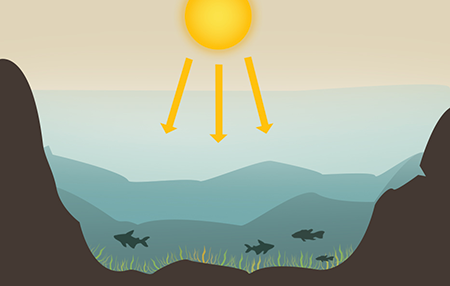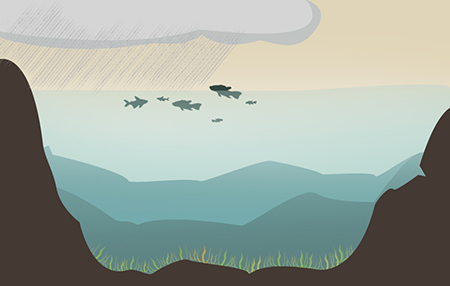Best Times to Fish
Temperatures

Too many hot days in the summer can make fish in shallow lakes, ponds and rivers sluggish. The same thing happens in the winter when water temperatures are lower. Why? All fish are cold-blooded. Meaning they can't keep their body temperature at a constant level like humans and other warm-blooded animals. So the temperature of their surroundings influences the fish's body temperature and bodily functions. Really high and really low water temperatures reduce the amount of oxygen in the water, making fish less active and picky about when and what they.
So here's the first rule of when to fish: fishing will be slower when it's too hot or too cold. Understanding this bit of biology will help you decide what kinds of lures and baits to use, and how fast or slow to work them. Work your tackle slower in colder water and faster in warm water.
Light
Fish prefer early morning and evening sun to the bright sun of midday. Morning sun warms the shallows, creating more comfortable water temperatures for fish to feed. Late morning is best when the sun has had more of a chance to warm the shallows. This is particularly true during early spring in shallows with dark or mud bottoms because dark areas absorb heat more rapidly than light sandy bottoms.
Warm water temperatures make bait fish more active and available to game fish on cool early-spring days. On hot sunny days, fish move to cooler, deeper waters to stay comfortable. High-heat conditions make shallow and top water lures and fishing bait best only in the early morning and late afternoon when cooler temperatures and lower light levels allow fish to cruise the shallows for meals.
In midday, hot water surface temperature, decreased surface oxygen and occasional increasing winds cause fish to move deeper. In these conditions, deep fishing baits, rigs and lures are best. Already, you can see how a combination of time of day, light and weather can affect your fishing.
Season
SPRING
EARLY MORNING
Fish aren't biting. The water is cold and doesn't heat up because the sun is low and the rays bounce off the water. Best to wait until a week or so after thaw, as spring turnover takes time for the water temperature to even out to 39.2 degrees.
LATE MORNING-EARLY AFTERNOON
Fish are biting off and on. The water begins to warm up because rays begin to penetrate the water. Remember to fish the downwind shoreline, as the winds will push the warmer surface water along with surface food into that area.
AFTERNOON-EARLY EVENING
Fish are eating a lot because their metabolism and digestion are cranked. Water is warm because the sun is directly overhead.
SUMMER
EARLY MORNING
Fishing is excellent from before sunup to just before mid-morning. At this time of year there is abundant food and cover for fish, so finding hungry fish can be a challenge.
LATE MORNING-EARLY AFTERNOON
Fishing is poor for most of the day. Fish move to deep water to cool off.
AFTERNOON-EARLY EVENING
Fishing is excellent from early sundown until dark as the waters cool and fish rise up from the depths.
FALL
EARLY MORNING
Fish aren't biting much from sunup to early morning. The water is cool because the sun is too low to penetrate the water.
LATE MORNING-EARLY AFTERNOON
Fish are biting off and on in warmer, shallow water. The water is generally cool due to the season.
AFTERNOON-EARLY EVENING
Fishing at this point is excellent. Sun is directly overhead for several hours and the water gets more comfortable near the surface. This makes for seasonally good fishing because fish are putting on weight for the winter.
Variable Weather Conditions

WIND
Wind can play a large role in when to fish and your fishing success. Wind pushes water and surface food to the far shore, with bait fish behind it, and with game fish behind the bait fish. So if you're fishing from shore on a windy day, fish where you have to cast into the wind. That way your lure moves with the wind, just like the other food in the lake at the same time. If you're fishing from a boat, cast with the wind on a sheltered shore.

STORMS
Storms and changing weather patterns affect fishing success since fish are keenly attuned to changes in barometric conditions. With many fish, feeding increases during the hours immediately before a cold front, but slows during and after a storm or front hits.
Fishing after a cold front is poor and continues to be poor for a day or two. Warm fronts cause surface water temperatures to increase, putting fish into a feeding mode. This can be particularly true in the winter, when a warming trend can cause otherwise sluggish fish to start feeding actively. Most of this feeding activity is on or near the warm surface.
CLOUDY DAYS
Cloudy days improve fishing since the clouds prevent light penetration. Overcast skies signal when to fish because they cause fish to cruise for food more than they would during bright days when they tend to hide and stay close to structure. On overcast, cloudy days, fish are less likely to be at specific structure spots or areas and more likely to be scattered throughout a waterway.
LIGHT RAIN
A light rain is another good time to fish, especially a warm spring or summer rain. Rain can help you hide from the fish since the rain breaks up the view a fish has through the water surface. This is true for shore, wade or boat fishing. Rain also washes insects and fishing bait into the water, creating a feeding binge for fish.
HARD RAIN
Hard rain conditions are a poor time to fish. A hard rain muddies the water, makes it difficult for fish to find bait or lures and causes heavy runoff, which can clog their gills. The increased water flow in rivers from any rain increases current flow and makes it difficult for fish to maintain a comfortable position in the river. High water levels can also create rapids, waves and unsafe fishing conditions.